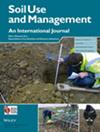Effects of composite soil conditioner on soil properties and corn yield in a saline–alkali soil
IF 3.7
3区 农林科学
Q1 SOIL SCIENCE
引用次数: 0
Abstract
Biochar is widely used in agricultural production because of its ability to improve the physical and chemical properties of soil and promote crop growth. In this study, a combination of different biochar and lake sediments were used to improve saline soils. The four raw materials, including corn stalk and chicken manure liquefaction product (SMLP), rice husk charcoal (RHC) and two types of sediment (S‐1 and S‐2), which was used to improve the saline–alkali soil, respectively. The most significantly effective applied on the soil was when the composite soil conditioner (CSC) prepared by mixing SMLP, RHC, S‐1 and S‐2 at 5:20:6000:500 t·100 ha复合土壤改良剂对盐碱地土壤特性和玉米产量的影响
生物炭能改善土壤的物理和化学性质,促进作物生长,因此被广泛应用于农业生产中。本研究采用不同生物炭和湖泊沉积物的组合来改良盐碱地。四种原料包括玉米秸秆和鸡粪液化产物(SMLP)、稻壳炭(RHC)和两种沉积物(S-1 和 S-2),分别用于改良盐碱地。将 SMLP、RHC、S-1 和 S-2 按 5:20:6000:500 t-100 ha-1 的比例混合配制成的复合土壤改良剂(CSC)对土壤的改良效果最明显。使用上述混合比例的土壤实验结果表明,玉米的穗重、株高和根长分别增加了 12.49%、47.17% 和 22.10%,土壤的 pH 值和导电率(EC)分别降低了 4.83%和 24.02%。土壤养分、土壤有机质(SOM)、含水量(WC)和可溶性阳离子(K+、Ca2+ 和 Mg2+)含量均呈上升趋势,土壤中 Na+和可溶性阴离子(Cl-、CO32-、HCO3- 和 SO42-)含量呈下降趋势。因此,生物炭与疏浚泥沙的复合土壤改良剂能协同改善土壤物理结构,增加养分含量,有利于促进玉米的生长特性和产量。
本文章由计算机程序翻译,如有差异,请以英文原文为准。
求助全文
约1分钟内获得全文
求助全文
来源期刊

Soil Use and Management
农林科学-土壤科学
CiteScore
7.70
自引率
13.20%
发文量
78
审稿时长
3 months
期刊介绍:
Soil Use and Management publishes in soil science, earth and environmental science, agricultural science, and engineering fields. The submitted papers should consider the underlying mechanisms governing the natural and anthropogenic processes which affect soil systems, and should inform policy makers and/or practitioners on the sustainable use and management of soil resources. Interdisciplinary studies, e.g. linking soil with climate change, biodiversity, global health, and the UN’s sustainable development goals, with strong novelty, wide implications, and unexpected outcomes are welcomed.
 求助内容:
求助内容: 应助结果提醒方式:
应助结果提醒方式:


